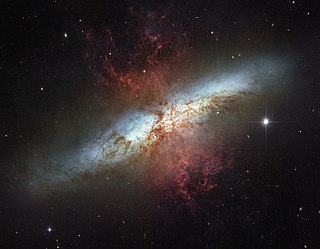
Messier 82 (also known as NGC 3034, Cigar Galaxy or M82) is a starburst galaxy approximately 12 million light-years away in the constellation Ursa Major. It is the second-largest member of the M81 Group, with the D25 isophotal diameter of 12.52 kiloparsecs (40,800 light-years). It is about five times more luminous than the Milky Way and its central region is about one hundred times more luminous. The starburst activity is thought to have been triggered by interaction with neighboring galaxy M81. As one of the closest starburst galaxies to Earth, M82 is the prototypical example of this galaxy type. SN 2014J, a type Ia supernova, was discovered in the galaxy on 21 January 2014. In 2014, in studying M82, scientists discovered the brightest pulsar yet known, designated M82 X-2.
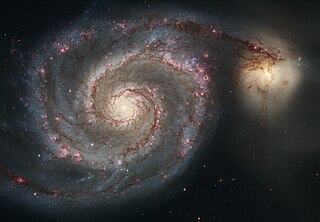
The Whirlpool Galaxy, also known as Messier 51a (M51a) or NGC 5194, is an interacting grand-design spiral galaxy with a Seyfert 2 active galactic nucleus. It lies in the constellation Canes Venatici, and was the first galaxy to be classified as a spiral galaxy. It is about 31 million light-years (9.5 Mpc) away from Earth and 76,900 ly (23,580 pc) in diameter.
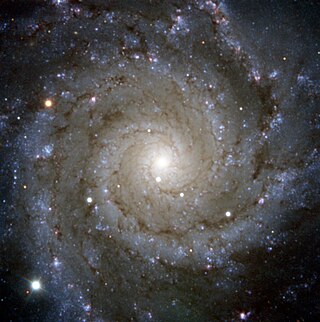
Messier 74 is a large spiral galaxy in the equatorial constellation Pisces. It is about 32 million light-years away from Earth. The galaxy contains two clearly defined spiral arms and is therefore used as an archetypal example of a grand design spiral galaxy. The galaxy's low surface brightness makes it the most difficult Messier object for amateur astronomers to observe. Its relatively large angular size and the galaxy's face-on orientation make it an ideal object for professional astronomers who want to study spiral arm structure and spiral density waves. It is estimated that M74 hosts about 100 billion stars.

NGC 6946, sometimes referred to as the Fireworks Galaxy, is a face-on intermediate spiral galaxy with a small bright nucleus, whose location in the sky straddles the boundary between the northern constellations of Cepheus and Cygnus. Its distance from Earth is about 25.2 million light-years or 7.72 megaparsecs, similar to the distance of M101 in the constellation Ursa Major. Both were once considered to be part of the Local Group, but are now known to be among the dozen bright spiral galaxies near the Milky Way but beyond the confines of the Local Group. NGC 6946 lies within the Virgo Supercluster.

NGC 891 is an edge-on unbarred spiral galaxy about 30 million light-years away in the constellation Andromeda. It was discovered by William Herschel on October 6, 1784. The galaxy is a member of the NGC 1023 group of galaxies in the Local Supercluster. It has an H II nucleus.

NGC 7331, also known as Caldwell 30, is an unbarred spiral galaxy about 40 million light-years (12 Mpc) away in the constellation Pegasus. It was discovered by William Herschel in 1784. NGC 7331 is the brightest galaxy in the field of a visual grouping known as the NGC 7331 Group of galaxies. In fact, the other members of the group, NGC 7335, 7336, 7337 and 7340, lie far in the background at distances of approximately 300-350 million light years.

The Katzman Automatic Imaging Telescope (KAIT) is an automated telescope used in the search for supernovae.

NGC 3370 (also known as UGC 5887 or Silverado Galaxy) is a spiral galaxy about 98 million light-years away in the constellation Leo. It is comparable to our Milky Way both in diameter (100,000 light years) and mass (1011 solar masses). NGC 3370 exhibits an intricate spiral arm structure surrounding a poorly defined nucleus. It is a member of the NGC 3370 Group of galaxies, which is a member of the Leo II Groups, a series of galaxies and galaxy clusters strung out from the right edge of the Virgo Supercluster.

NGC 1309 is a spiral galaxy located approximately 120 million light-years away, appearing in the constellation Eridanus. It is about 75,000 light-years across, and is about 3/4s the width of the Milky Way. Its shape is classified as SA(s)bc, meaning that it has moderately wound spiral arms and no ring. Bright blue areas of star formation can be seen in the spiral arms, while the yellowish central nucleus contains older-population stars. NGC 1309 is one of over 200 members of the Eridanus Group of galaxies.

The known history of supernova observation goes back to 1006 CE. All earlier proposals for supernova observations are speculations with many alternatives.
SN 2003H was a supernova that appeared halfway between the colliding NGC 2207 and IC 2163 galaxies. It was discovered on January 8, 2003, by the Lick Observatory and Tenagra Supernova Searches (LOTOSS).

NGC 2770 is a spiral galaxy in the northern constellation of Lynx, near the northern constellation border with Cancer. It was discovered by German-born astronomer William Herschel on December 7, 1785. J. L. E. Dreyer described it as, "faint, large, much extended 150°, mottled but not resolved, 2 stars to north". NGC 2770 was the target for the first binocular image produced by the Large Binocular Telescope.

NGC 7424 is a barred spiral galaxy located 37.5 million light-years away in the southern constellation Grus. Its size makes it similar to our own galaxy, the Milky Way. It is called a "grand design" galaxy because of its well defined spiral arms. Two supernovae and two ultraluminous X-ray sources have been discovered in NGC 7424.
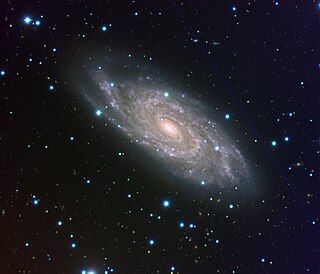
NGC 6118 is a grand design spiral galaxy located 83 million light-years away in the constellation Serpens. It measures roughly 110,000 light-years across; about the same as our own galaxy, the Milky Way. Its shape is classified as "SA(s)cd," meaning that it is unbarred and has several rather loosely wound spiral arms. The large numbers of bright bluish knots are active star-forming regions where some very luminous and young stars can be perceived.
SN 2013ej is a Type II-P supernova in the nearby spiral galaxy Messier 74. It was discovered by the Lick Observatory Supernova Search on July 25, 2013, with the 0.76 m Katzman Automatic Imaging Telescope, with pre-discovery images having been taken the day before.

NGC 7047 is an intermediate spiral galaxy located about 270 million light-years away in the constellation of Aquarius. NGC 7047 is also classified as a LINER-type galaxy. NGC 7047 has an estimated diameter of 127,350 light years. It was discovered by French astronomer Édouard Stephan on August 20, 1873. In 2009 a supernova was found in NGC 7047.
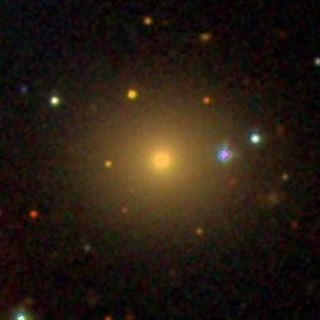
NGC 1259 is a lenticular galaxy located about 243 million light-years away in the constellation Perseus. The galaxy was discovered by astronomer Guillaume Bigourdan on October 21, 1884 and is a member of the Perseus Cluster.

NGC 1268 is a spiral galaxy located about 140 million light-years away in the constellation Perseus. It was discovered by astronomer Heinrich d'Arrest on February 14, 1863. NGC 1268 is a member of the Perseus Cluster and appears to show signs of distortion in the form of bridges. These features may be the result of a strong interaction with NGC 1267.

NGC 2280 is a spiral galaxy located in the constellation Canis Major. It is located at a distance of circa 75 million light years from Earth, which, given its apparent dimensions, means that NGC 2280 is about 135,000 light years across. It was discovered by John Herschel on February 1, 1835. One supernova has been observed in NGC 2280, SN 2001fz, a type II supernova discovered by the Beijing Astronomical Observatory Supernova Survey on November 15, 2001. It had a peak magnitude of 17.4.

NGC 4070 is an elliptical galaxy located 340 million light-years away in the constellation Coma Berenices. NGC 4070 was discovered by astronomer William Herschel on April 27, 1785. It was rediscovered by John Herschel on April 29, 1832 and was listed as NGC 4059. The galaxy is a member of the NGC 4065 Group.


















